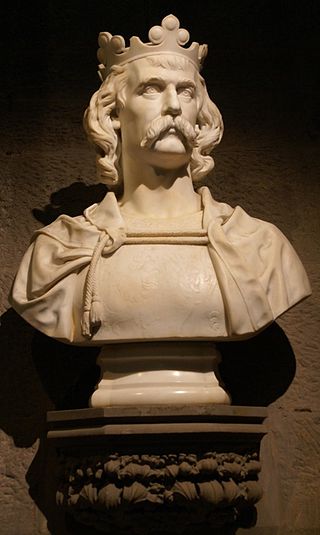
Robert I, popularly known as Robert the Bruce, was King of Scots from 1306 to his death in 1329. Robert led Scotland during the First War of Scottish Independence against England. He fought successfully during his reign to restore Scotland to an independent kingdom and is regarded in Scotland as a national hero.

The Wars of Scottish Independence were a series of military campaigns fought between the Kingdom of Scotland and the Kingdom of England in the late 13th and early 14th centuries.
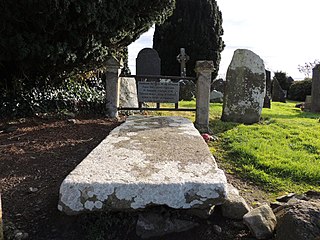
Edward Bruce, Earl of Carrick, was a younger brother of Robert the Bruce, King of Scots. He supported his brother in the 1306–1314 struggle for the Scottish crown, then pursued his own claims in Ireland. Proclaimed High King of Ireland in 1315 and crowned in 1316, he was eventually defeated and killed by Anglo-Irish forces of the Lordship of Ireland at the Battle of Faughart in County Louth in 1318.
Andrew Moray, also known as Andrew de Moray, Andrew of Moray, or Andrew Murray, was an esquire, who became one of Scotland's war-leaders during the First Scottish War of Independence. Moray, son and heir to Sir Andrew Moray of Petty, initially raised a small band of supporters at Avoch Castle in early summer 1297 to fight King Edward I of England. He soon had successfully regained control of the north for the absent Scots king, John Balliol. Moray subsequently merged his army with that of William Wallace, and jointly led the combined army to victory at the Battle of Stirling Bridge on 11 September 1297. In the fighting at Stirling, Moray was severely wounded. He died at an unknown date and place that year.
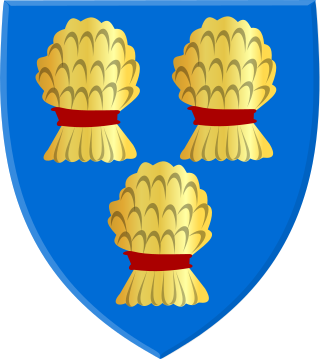
John Comyn III of Badenoch, nicknamed the Red, was a leading Scottish baron and magnate who played an important role in the First War of Scottish Independence. He served as Guardian of Scotland after the forced abdication of his uncle, King John Balliol, in 1296, and for a time commanded the defence of Scotland against English attacks. Comyn was stabbed to death by Robert the Bruce before the altar at the church of the Greyfriars at Dumfries, once it had been declared that Comyn had more connection to King David of Scotland and therefore should be the next King of Scotland, not Robert.
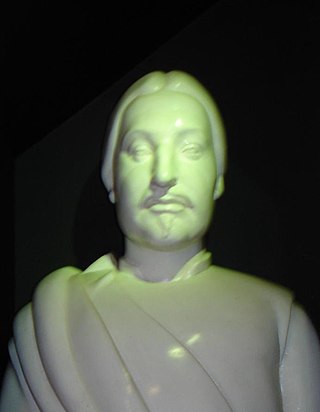
William II, Earl of Ross was ruler of the province of Ross in northern Scotland, and a prominent figure in the Wars of Scottish Independence.

The Battle of the Pass of Brander in Scotland forms a small part of the wider struggle known as the Wars of Scottish Independence, and a large part of the civil war between the Bruce and Balliol factions, a parallel and overlapping conflict. It was a victory for King Robert the Bruce over the MacDougalls of Argyll, kinsmen of John Comyn, also known as the Red Comyn, who had been killed by Bruce and his adherents at Dumfries in 1306. The sources do not allow us to determine the date of the battle with any degree of precision: various dates between 1308 and 1309 have been suggested, though the late summer of 1308 would seem to be the most likely. Traquair dates it to August 1308.

John Comyn, 3rd Earl of Buchan was a chief opponent of Robert the Bruce in the civil war that paralleled the War of Scottish Independence. He should not be confused with the better known John III Comyn, Lord of Badenoch, who was his cousin, and who was killed by Bruce in Dumfries in March 1306. Confusion between the two men has affected the study of this period of history.
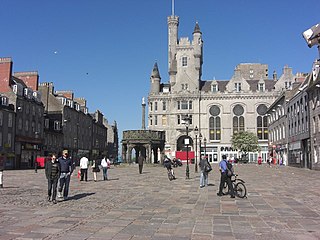
Aberdeen Castle was a late Middle Ages fortification, in Aberdeen, Scotland. It was situated on Castle Hill, a site today known as the Castlegate, and the location of the castle is now occupied by blocks of flats.

The Castle of Rattray was a medieval Scottish castle, with multiple variations on its structure over approximately six centuries. Originally built as a "late 12th- or early 13th century defensive motte" it provided protection for Starny Keppie Harbour and Rattray village. Sometime between 1214 and 1233 it was upgraded by William Comyn, jure uxoris Earl of Buchan before being destroyed in the 1308 Harrying of Buchan. After Comyn's timber castle was burned down, it was replaced by a stronger stone castle which was engulfed during a 1720 sand storm along with nearby Rattray village. After the storm, the castle was not dug out and remains covered to this day. The castle was described by W. Douglas Simpson as one of the nine castles of the Knuckle, referring to the rocky headland of north-east Aberdeenshire.
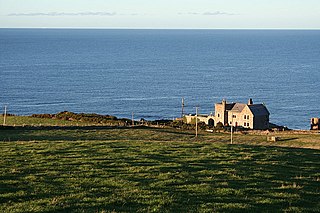
Dundarg Castle is a ruined castle about 2 kilometres (1.2 mi) north-northeast of New Aberdour, Aberdeenshire, Scotland, built within the ramparts of an earlier Iron Age promontory fort. It was described by W. Douglas Simpson as one of the nine castles of the Knuckle, referring to the rocky headland of North-East Aberdeenshire, and by Charles McKean as "Scotland's answer to Tintagel". It became a small Celtic monastery for a period.
Alice Comyn, Countess of Buchan, Lady Beaumont was a Scottish noblewoman, a member of the powerful Comyn family which supported the Balliols, claimants to the disputed Scottish throne against their rivals, the Bruces. She was the niece of John Comyn, Earl of Buchan, to whom she was also heiress, and after his death the Earldom of Buchan was successfully claimed by her husband Henry de Beaumont, Earl of Buchan, by right of his wife. His long struggle to claim her Earldom of Buchan was one of the causes of the Second War of Scottish Independence.

Clan Cumming, also known as Clan Comyn, is a Scottish clan from the central Highlands that played a major role in the history of 13th-century Scotland and in the Wars of Scottish Independence. The Clan Comyn was once the most powerful family in 13th-century Scotland, until they were defeated in civil war by their rival to the Scottish throne, Robert the Bruce.

Barra Castle is an unusual L-plan tower house dating from the early 16th century, about two miles south of Oldmeldrum, above the Lochter Burn, in the parish of Bourtie, Aberdeenshire, Scotland. It occupies the site of the Battle of Inverurie (1308), in which Robert Bruce defeated John Comyn, Earl of Buchan.
Sir Walter de Berkley 8th of Gartly was a 13th-14th century Scottish noble.
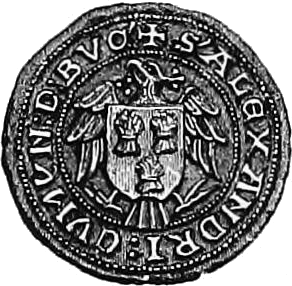
Alexander Comyn, Sheriff of Aberdeen was a fourteenth-century Scottish nobleman. He was a younger son of Alexander Comyn, Earl of Buchan. The latter died in 1290, whereupon the earldom of Buchan was inherited by Alexander's elder brother, John.
William Wiseman, Sheriff of Elgin (1304-1305) was a 13th-14th century Scottish nobleman. He was a soldier during the First War of Scottish Independence.
Dalswinton Castle, also known as Comyn's Castle, was a castle that was located to the south-east of Dalswinton, in Dumfries and Galloway, Scotland.












